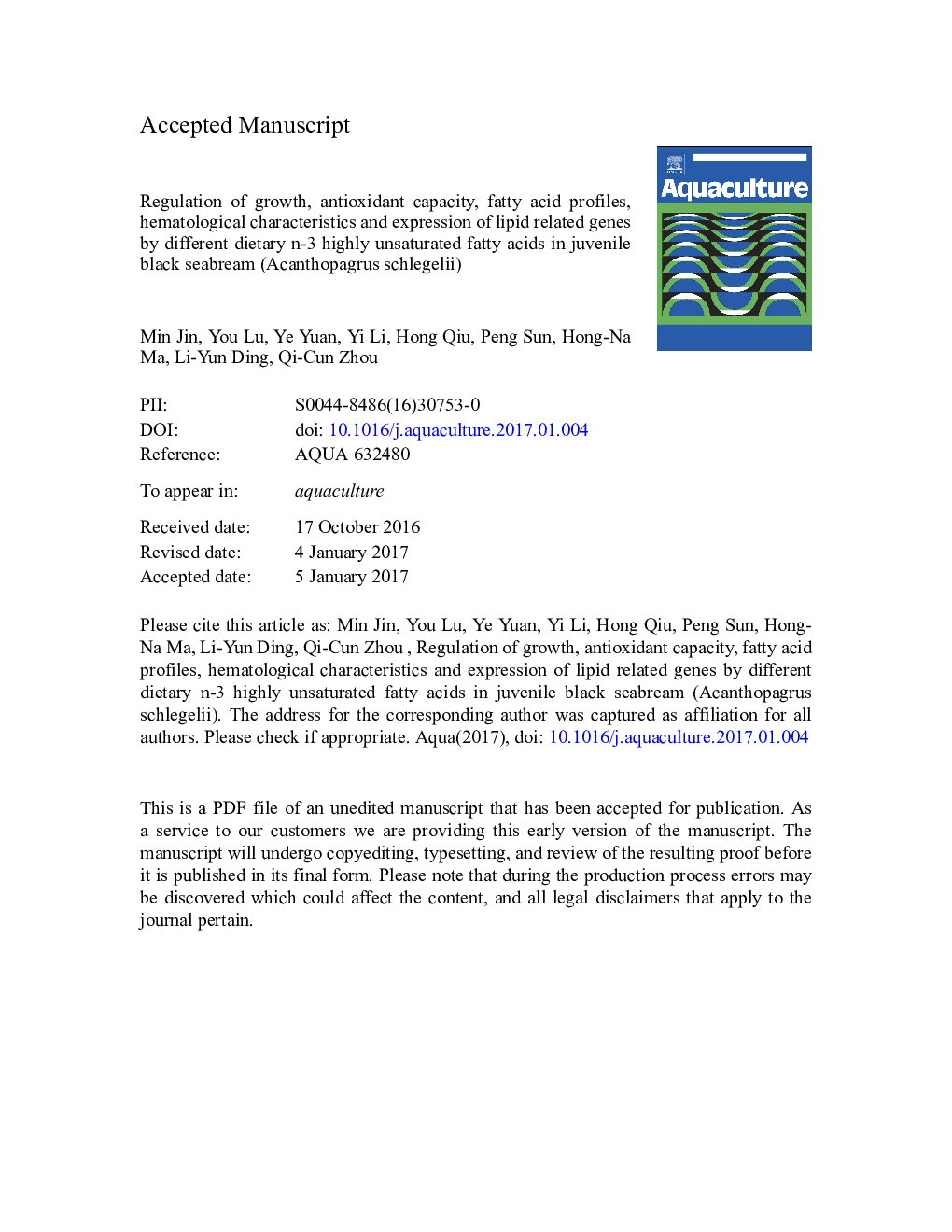| کد مقاله | کد نشریه | سال انتشار | مقاله انگلیسی | نسخه تمام متن |
|---|---|---|---|---|
| 5539551 | 1552817 | 2017 | 48 صفحه PDF | دانلود رایگان |
عنوان انگلیسی مقاله ISI
Regulation of growth, antioxidant capacity, fatty acid profiles, hematological characteristics and expression of lipid related genes by different dietary n-3 highly unsaturated fatty acids in juvenile black seabream (Acanthopagrus schlegelii)
دانلود مقاله + سفارش ترجمه
دانلود مقاله ISI انگلیسی
رایگان برای ایرانیان
کلمات کلیدی
LPL6PGDFADS2ACCαSREBP-1ELOVL5HSLPPARαCpt1aFASG6PDAtgl - اتگلacetyl-CoA carboxylase alpha - استیل کروکسی سیلاز آلفاFatty acid - اسید چربfatty acid synthase - اسید چرب سنتازBlack seabream - دریای سیاهAntioxidant capacity - ظرفیت آنتی اکسیدانGrowth performance - عملکرد رشدadipose triglyceride lipase - لیپاز تری گلیسیرید چربیhormone-sensitive lipase - لیپاز حساس به هورمونLipoprotein lipase - لیپو پروتئین لیپازSterol regulatory element-binding protein-1 - پروتئین 1-اتصال دهنده به سلول استرولcarnitine palmitoyltransferase 1a - کارنتین پالمیتیل ترانسفراز 1aglucose 6-phosphate dehydrogenase - گلوکز 6-فسفات دهیدروژناز
موضوعات مرتبط
علوم زیستی و بیوفناوری
علوم کشاورزی و بیولوژیک
علوم آبزیان
پیش نمایش صفحه اول مقاله

چکیده انگلیسی
An 8-week feeding trial was conducted to investigate the effects of dietary n-3 highly unsaturated fatty acid (n-3HUFA) on growth performance, antioxidant capacity, fatty acid profiles, hematological characteristics and expression of some lipid related genes of juvenile black seabream (Acanthopagrus schlegelii) (initial weight 3.77 ± 0.00 g). Five isonitrogenous and isolipidic experimental diets were formulated with graded levels of n-3 HUFA (0.23, 0.87, 1.29, 1.75 and 2.53% of dry weight, DHA/EPA ratio approximately at 1.0). The results revealed that fish fed the diet containing 1.75% n-3 HUFA had higher weight gain (WG) and specific growth rate (SGR) than those fed the control diet. Fish fed diets containing 1.29% and 1.75% n-3 HUFA had higher feed efficiency (FE) than those fed the other diets. Hepatic and muscular fatty acid profiles reflected that of diets. The content of malondialdehyde (MDA) increased both in the serum and liver of fish fed high n-3 HUFA level diets, and the highest hepatic activity of glutathione peroxidase (GSH-PX) was recorded in fish fed the diet containing 1.29% n-3 HUFA. The expression of accα, g6pd, fas, srebp-1, lpl, atgl, hsl, elovl5 and fads2 was down-regulated in fish fed the diets with high n-3 HUFA levels. However, the expression levels of 6pgd and pparα significantly increased when the dietary contents of n-3 HUFA increased from 0.23% to 1.29% and then decreased when dietary n-3 HUFA levels increased from 1.75% to 2.53%. The highest expression of cpt1a was found in fish fed the diet containing 1.75% n-3 HUFA. The content of cholesterol (CHOL) in serum increased along with n-3 HUFA level. Over all, this study indicated that fish fed moderate dietary n-3 HUFA (1.34-1.80% n-3 HUFA) could enhance growth, feed utilization and antioxidant capacity. Different dietary levels of n-3 HUFA could strongly affect expression levels of some lipid metabolism relevant genes of the juvenile black seabream. This may contribute to our understanding of the mechanisms related to lipid metabolism (anabolism and catabolism) effects of different dietary levels of n-3 HUFA.
ناشر
Database: Elsevier - ScienceDirect (ساینس دایرکت)
Journal: Aquaculture - Volume 471, 20 March 2017, Pages 55-65
Journal: Aquaculture - Volume 471, 20 March 2017, Pages 55-65
نویسندگان
Min Jin, You Lu, Ye Yuan, Yi Li, Hong Qiu, Peng Sun, Hong-Na Ma, Li-Yun Ding, Qi-Cun Zhou,